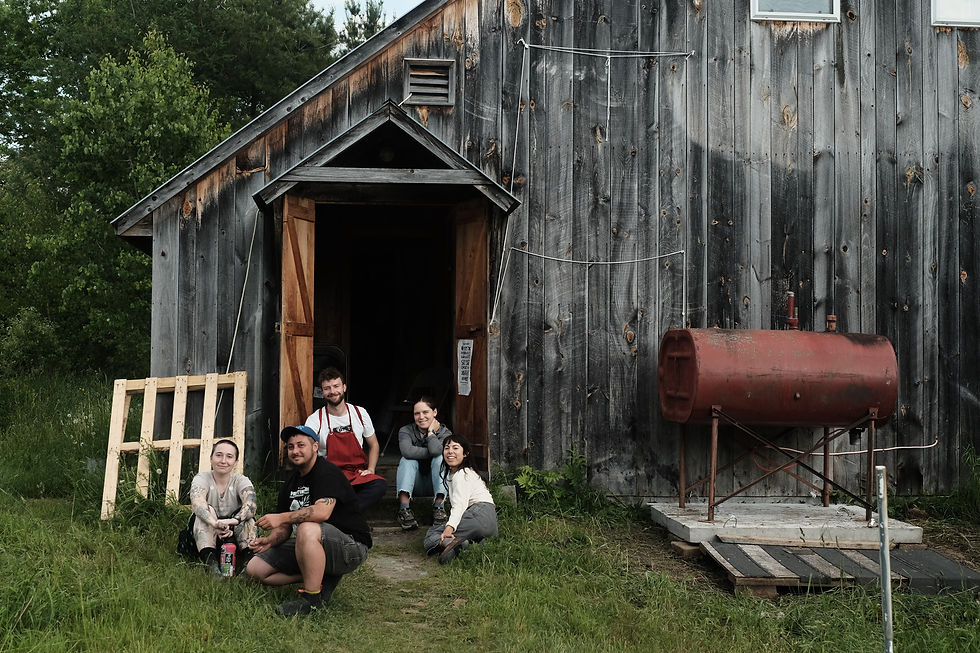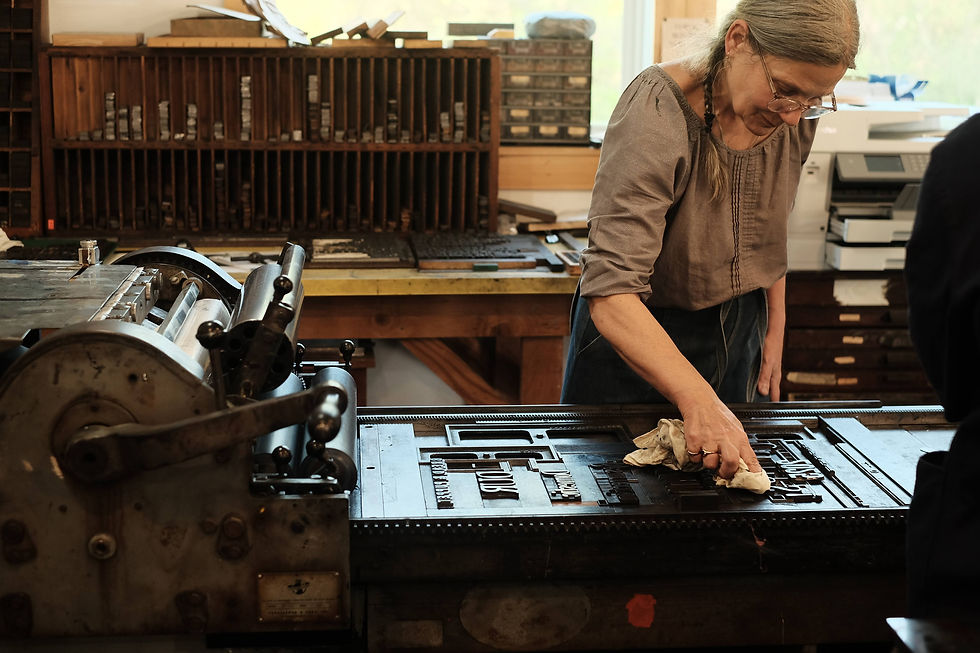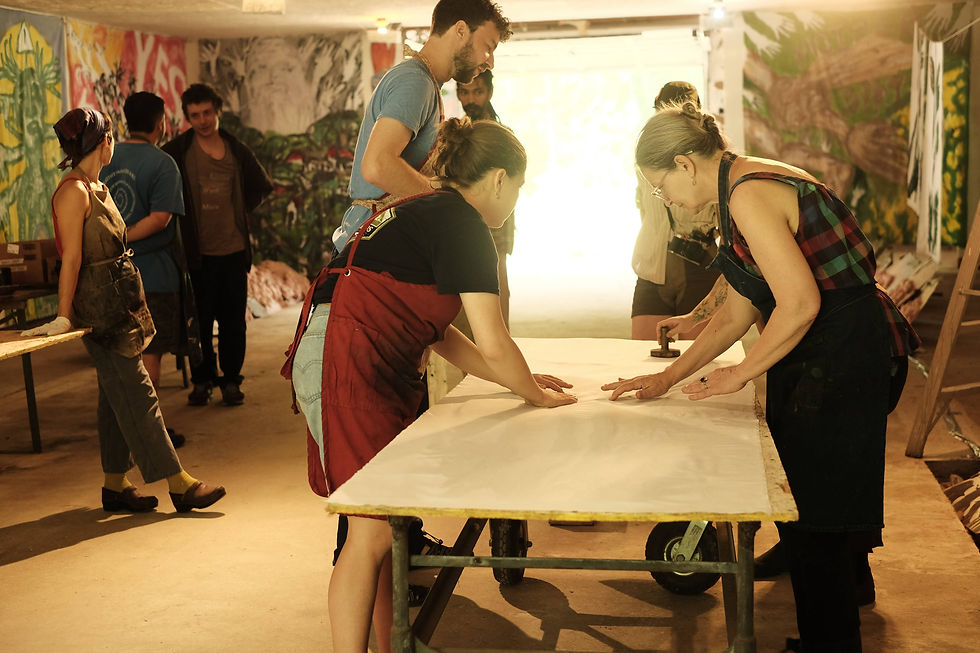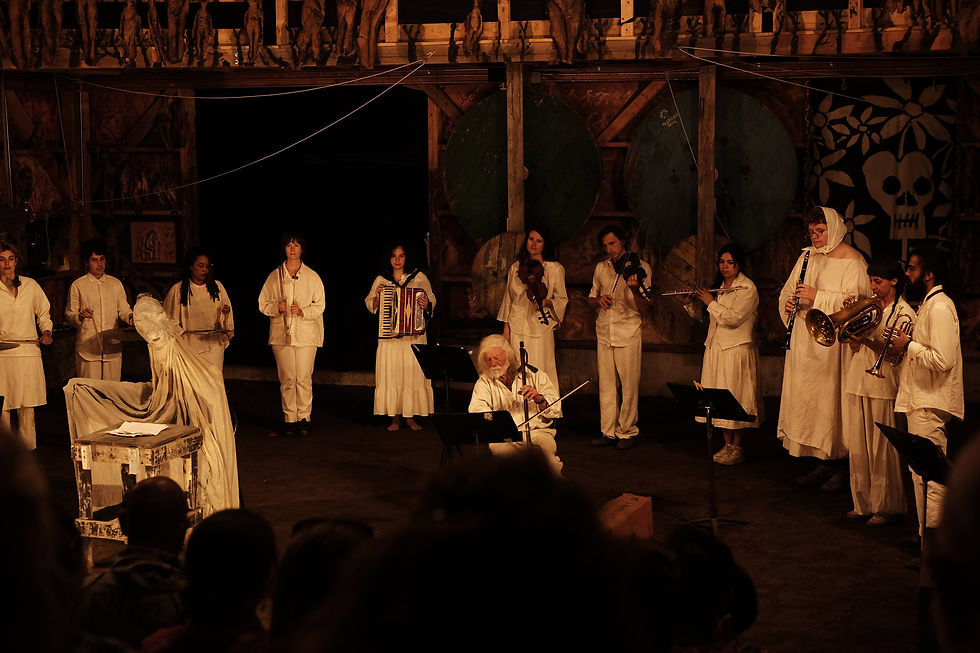BREAD & PUPPET, VERMONT (Part 1)
- quentinberoud

- Jul 27
- 9 min read
I am dressed all in white, kneeling on a dirt floor, scrambling away from a papier-mâché monster. This is happening in front of an audience of 200 people. I have no idea what I’m doing. The first and only rehearsal we had for this show was three hours earlier. Later I will be paid for this performance with a small loaf of very dense German bread.
It’s 9:30AM. This time I’m wearing grey robes and waving a giant poppy banner. I’m part of a 20-strong group marching up a hill, chanting. We are a boat, complete with mast, moorings and a fabric hull. A 91-year-old man is shouting at us to chant louder. This will be seen by thousands of people.
We’re at a dinner party in the Green Mountains. Bertolt Brecht’s grandson offers me a canapé. It’s delicious. He asks us if we plan to have kids anytime soon.

These might sound like oddly specific cheese dreams, and it’s true that Vermont had the only nice cheese we tried on the trip, but these are in fact fairly standard experiences when you’re staying at the Bread & Puppet farm in Glover, Vermont. We were lucky enough to be accepted onto the Printing Press apprenticeship, and so got to spend two weeks of our trip living on what can best be described as a leftist puppet commune. We’re now back in the UK, and “what was the best place you went to?” is a common question. It’s hard not to answer Bread & Puppet, because the whole thing was so magical, but it’s also very hard to convey what it was like, because, well… Marxist Puppet Commune.


When we pull into the farm, the first thing we see is a group of puppeteers rehearsing a show (the same one I will be in). They are being directed by an old man with flowing white hair and beard. He is topless in the sunshine, a beer in one hand and a huge cigar in the other. I’ve never seen a more idyllic vision of old age. His name is Peter Schumann, the co-founder and director of Bread & Puppet, and he will turn 91 while we’re staying on the farm. If anyone was wondering, the secret to a long and happy life is to surround yourself with creativity, a blend of old friends and a constant influx of new people who think you’re a legend, and doing something you love. Probably having a massive farm in rural Vermont is helpful too.

Everything about the theatre and the print shop emanates from Peter’s boundless creativity.

He produces an astonishing number of drawings, books and Masonite carvings, which are turned into beautiful posters and banners at the print shop, initially the brainchild of his wife, Elke, and now run by two of their daughters.

This print shop is where we spend most of our time, learning the ropes of how to produce Bread & Puppet prints on two venerable 1960s presses (Vandercook SP20s, if you’re into that sort of thing).


The application form for the apprenticeship made it clear that you didn’t need any previous experience in printmaking, which was just as well for me (as I had none), but it’s a deeply satisfying activity. Also deeply frustrating, rewarding patience and savagely punishing any cut corners.

Of all the print shop activities, typesetting was one that tapped into a nerd node of my brain I didn't know I had. It's fonts IRL! The feeling of completion when you set a sentence or paragraph with your hands (not bare hands, mind, 'cause that lead will get you in the end), of setting it on the page and cranking the big roller over it, makes you truly appreciate well-crafted words. And yes, I do see the irony of writing this on my blog.

Fun fact: the drawer where the letters are kept was re-organised to prioritise letters and symbols that are used most, much in the way a keyboard is laid out to maximise efficiency when you type. Apparently when this was first brought in it saved type setters on newspapers an average of three miles of hand movement a day. (Pretty fun, right? RIGHT?!)

In the evenings and weekends, our group were given free rein of the place, like being let loose in a sweet shop (no more “candy” for me) you never knew you wanted to enter. We were encouraged to work on our own "Cheap Art" projects, following in a movement that started in 1980 as a rebuke to the abstract expressionism that had lost its radical roots and sold out to the art market. Peter would sometimes pop up at the Print Shop and start singing his Cheap Art Song:
One for two, two for three, you want three? That's great they're free!
Which we can all agree is not a good song, and an even worse business strategy, but very liberating when it comes to making art with no pressure or expectation.
A word on our group. I’m sure every cohort of Print Shop apprentices feel that they are the best group, and I’m sure they get told that, but that doesn’t stop the fact that we were the best.

In our giddy arrogance we referred to ourselves exclusively as “The Print Shop Apprentices”, ignoring the fact that there have been many before us, and there are at least two more groups coming just this summer. The combination of learning a tricky new skill whilst being given creative freedom is like social catnip, and I really feel like we have friends for life.


This includes those who taught us with such patience and good grace and ferried us around to various idyllic swim spots in the Green Mountains. If you’re looking for a good bonding activity, may I recommend putting way too much effort into your fancy dress costumes and arriving much too late to a wedding of two near-strangers you only met the week before.

If that sounds a little niche, well, the whole place is niche, frankly. I can only remember one other time like it in my life: my first time doing a show at the Edinburgh Fringe as an 18-year-old. That too was an explosion of creativity, community, freedom and joy.




How to give you a fuller picture of the place? Let's start with the name: Bread & Puppet. The puppets are self-explanatory; it would be worth visiting the farm just for the museum, where hundreds of puppets from 60 years of shows are arranged over two floors of a huge barn.
When the lights are on, it’s one of the most magical places I’ve been in. When the lights are off… easily the creepiest.


The bread is, in fact, also pretty clear-cut, though it points to the more radical roots of the theatre. Peter and Elke were keen for the performances not to be a passive experience, a one-way telling of stories to punters who pay their money, sit back with folded arms and expect to be entertained. They wanted to create more of a shared moment. As such, at the end of every show, the cast serve bread and aioli to the audience, encouraging them to stay and chat. The bread is still made by Peter, with the help of puppeteers, who bake 200 loaves of this sourdough rye bread each week. He calls it German peasant bread, and all I can say it that whatever other problems they may have had, the Teutonic serfs must have been VERY regular, because that bread was fibrous as hell. No issues with gut microbiome here. The aioli should come with a content warning, as it’s basically just raw garlic smashed up with olive oil. Music to my French ears, of course, and I wonder if that’s also part of the trick of bringing people together: once you’ve had some, you’ll only be able to talk to other people who’ve eaten it for the rest of the evening.

There was a refrain that echoed through our two weeks: “Art is Bread. You can’t eat it, but it feeds you”. I’m now back in London, where the West End seems to be blindly following Broadway off the cliff of unaffordable tickets, and theatre is being priced into being Hollywood for people who want to dress up for the evening. And yet at Bread & Puppet, 200 local people showed up to see a show that didn’t yet have a name, had no clear narrative and was free to get into ($15 suggested donation). Audiences will still take risks on original shows if they’re cheap – though obviously it helps when the company has a 60-year track record of making incredible work.
I do feel very honoured to have been in a Bread & Puppet show, following in a long line of luminaries including Bernie Sanders. Legend has it he joined a show after being told off by Elke for campaigning at one of Bread & Puppet’s Summer Circuses. She told him he couldn’t just turn up when he wanted to win votes, so he appeared in some Bread & Puppet shows. Let me be clear, though, that being in a performance requires zero theatrical talent. In fact, if you’re on the farm on a Friday, it’s harder to not be in it, as Peter starts his recruitment drive early, and will ask relentlessly until he has an ensemble of at least 10 people.

Sorry to talk shop, but from a directing point of view, the idea of some non-actor strangers turning up to be in my production at 4pm for the first rehearsal of a show that’s going up in 3 and a half hours would terrify me. It’s also quite scary for the people showing up. But here again is a great example of Bread & Puppet make theatre less elitist, less “us-and-them” between audience and performer. They have a few tricks that allow them to create beautiful stage pictures with a freshly assembled squad of volunteers each week. The first is the all-white costumes for everyone, that create instant visual unity. Added to that, the dirt floor of the stage feels instantly elemental, another shortcut to creating a deeper meaning, such as when we all start picking up handfuls of dirt and throwing them back on the floor. There's something primordial about it, and it also contrasts beautifully with other aspects of the theatre - as you can see below, the scale and sophistication of the puppetry is pretty impressive.

Then, there are always enough puppeteers, people who know the show, onstage for you to follow. If you get lost, you just copy them. Perhaps most crucially, each scene with the chorus follows the same basic pattern: chaos to order. For example, in one scene we entered dragging masks before chucking them on the ground. I have to admit I did so with a slight hesitation, as the day before we’d had a presentation in the museum from Peter’s son Max, telling us that these same Grey Lady masks were a priceless example of Bread & Puppet artistry.

Nevertheless, we dumped these historic puppets unceremoniously on the ground in a big heap, me trying not to look at Max in the audience, and fanned out around them. Then one by one we picked up a Grey Lady, taking our lead from a puppeteer, and held it above us. As music played, we each gradually got to know the puppet, slowly feeling it out and until we got to grips with it, and had hidden ourselves under the folds of material beneath the mask. Every so often there was a gong, and we paused as one of the performers delivered a monologue. When I was in the show, I worried that I was taking too long to get under my puppet (not a euphemism).
When I watched the show the next week – having successfully resisted Peter’s recruitment drive – the scene was mesmerising, and the moment of transformation, when this group of people disappeared under the material and became the Grey Ladies, oddly tall and ashen faced, was instant and magical.

In another scene, we all stomped around the stage in our own track, but were told to listen out for one of the puppeteers, and gradually coalesced our stamps to synchronise with theirs. Chaos to order. The show had very little narrative and was in some ways hard to follow, but it also had five or six moments of hair-raising, shudder-down-your-spine beauty, which feels like pretty good going for an hour. I certainly came away from it inspired to find ways to make theatre that was bigger in scale and more inclusive of community, and much more confident of how to do it.



I hope I've started to convey how special this place is, through my words and Leyla's photos, but to be honest there's too much to say for one blog, even if you're not eating Peter's bread, so consider this part one. More to follow...











Comments